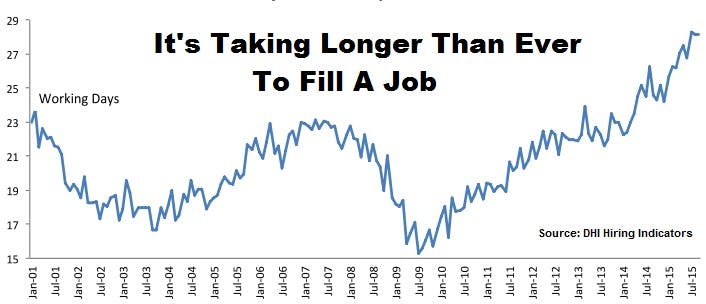After all the drumbeating about speeding up the hiring process or risking losing the best talent, the advice is being ignored and companies are indeed losing candidates they want to hire.
Agency recruiters in the MRI Network say it now takes more than three weeks from the first interview for candidates to get an offer. If that doesn’t seem long, you should know that three weeks is just about the quickest offers are being made. For 53 percent of the candidates MRI recruiters represent, it takes hiring managers more than five weeks to make an offer.
No surprise then that when an offer is rejected, 44 percent of the time it’s because the candidate has taken another job. Another 14 percent get turned down because they took their employer’s counteroffer.
If you’re tempted to dismiss these findings as something unique to MRI, that would be a mistake because the latest MRI Recruiter Sentiment Study echoes what other, broader analyses are finding: It is taking longer and longer to fill a job.
The DHI-DFH Mean Vacancy Duration Measure (from the company formerly known as Dice) has been climbing nearly every month. The report issued in November (covering September) says it now averages 28.1 working days to fill a job. That’s a national average for all jobs in all industries. Some sectors are having a far harder time filling openings. The November report cites two examples:
- 46.9 days to fill healthcare jobs, and;
- 46.8 days for financial services jobs.
Earlier this year, a Bersin by Deloitte blog, promoting the release of Talent Acquisition Factbook 2015, said the benchmarking report found companies reporting it takes them an average of 52 days to fill a job, up from 48 days in 2011.
Why is it taking so long to fill jobs? For some occupations, certainly, there are more jobs than candidates.
Michael Durney, CEO of DHI Group, which sponsors the report, says,“Our customers tell us positions which are particularly difficult-to-fill include nurses, developers, and (IT) security professionals.”
In other cases, as Durney notes, it’s the quest to find the best qualified talent: “Hiring managers tell us the time to fill open positions has lengthened compared to last year, primarily due to a struggle to find qualified candidates.”
More than a few recruiters say there are other factors at work, including qualification inflation and hiring manager fear of making a mistake. Since the Great Recession, companies have raised the stakes, demanding ever-higher levels of performance with the same or fewer employees. That puts tremendous pressure on managers to hire well, which is prompting them to demand more experience and more skills, even when the job doesn’t require everything they want.
Whatever is behind the ever growing time to fill — and very likely it’s a combination of all these factors — John Sullivan estimates the economic impact “from missing a single game-changer, purple squirrel, or innovator recruit to be over $1 million each.”
The biggest losers also tend to be the largest companies. According to the DHI Hiring Indicators reports, employers with more than 5,000 workers averaged 61.3 days to fill a job over the seven months from Jan-Aug. That is a 51 percent increase since the end of the recession in 2009.
Averages, of course, are just that, making it possible for some very hard-to-fill positions to skew an overall time to fill statistic. The MRI Recruiter Sentiment Study strongly says that is not what’s happening.
Keep in mind that the candidates presented by third party recruiters like those working for MRI have already been vetted by recruiters with a powerful incentive — earning a fee — for presenting the best talent. Yet it still is taking a majority of hiring managers at least five weeks to make an offer.
It may be a testament to their candidate relationship skills that most MRI recruiters — 73 percent — report a turndown rate of 10 percent of less.
Yet that still leaves 27 percent of the recruiters who have experienced higher candidate rejection rates, even higher than 25 percent for some.
And while candidates turn them down because they’ve taken other jobs, the second leading reason is the package they were offered was lower than they expected.
As one MRI recruiter said in response to the survey, which again found 90 percent of the respondents declaring the labor market to be driven by candidates:
“Despite being in a heavily candidate-driven market for several years, most companies still follow antiquated hiring practices, even for critical positions. They refuse to acknowledge that the market is candidate-driven”
